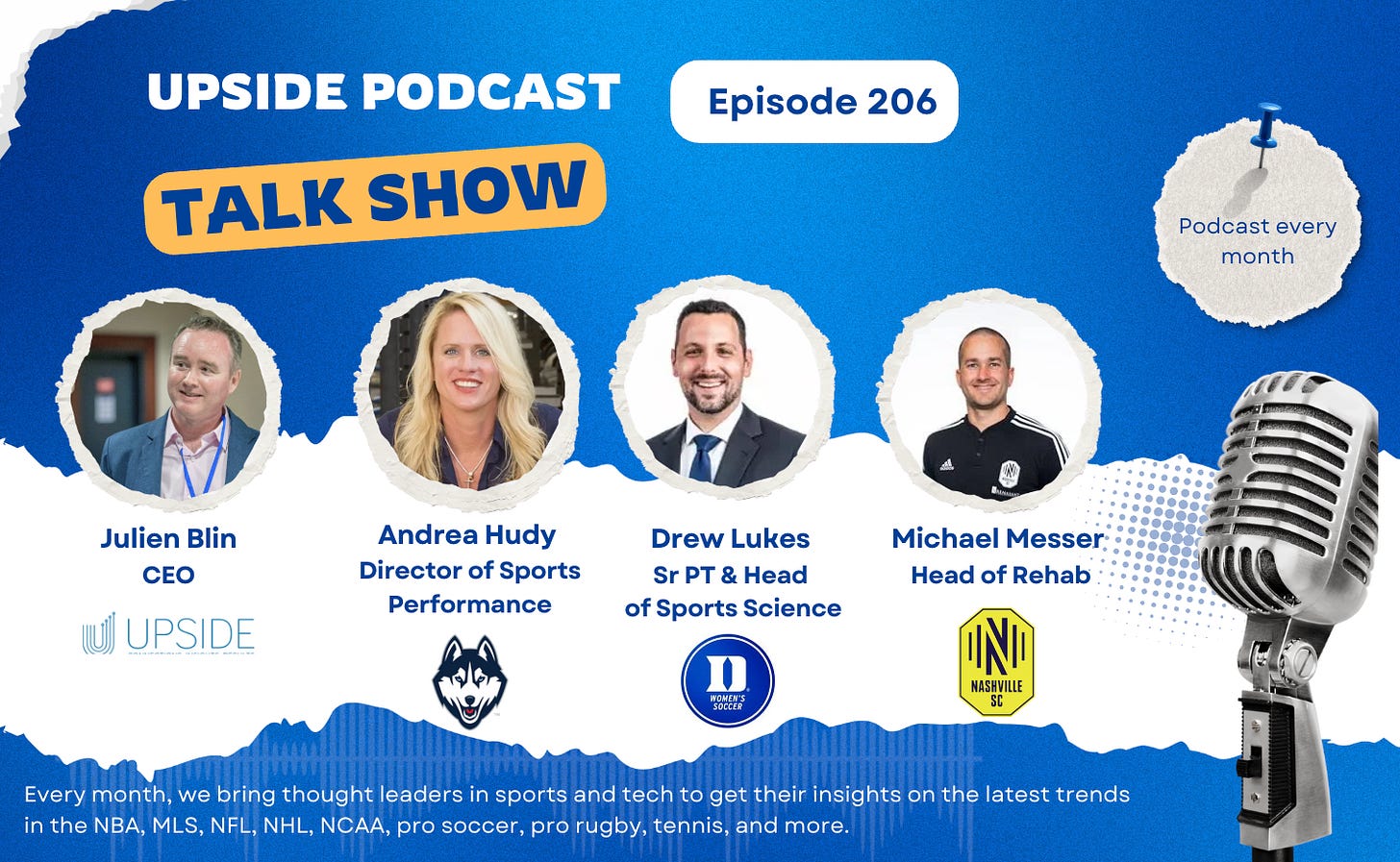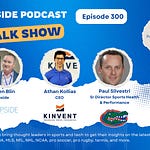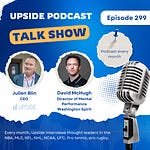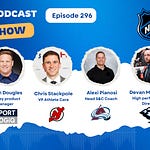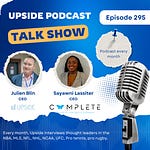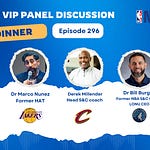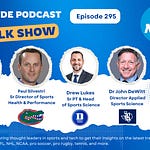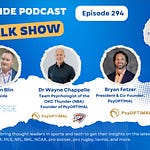This week we had the honor to interview again a group of sports performance experts.
Andrea Hudy, the director of sports performance for the University of Connecticut (UCONN)’s women basketball team, a top NCAA team.
Drew Lukes, Senior PT at Duke University and the head of sports science for Duke university’s women soccer team, a top NCAA team.
Michael Messer, the head of rehabilitation for Nashville SC, a top MLS team.
You can read the full transcript of the podcast interview with Andrea, Drew and Michael located at the top of this blog post.
Here are some of the best quotes of our conversation with them:
1. Commonalities and Differences
Q: What are the primary differences in approach to sports performance and rehabilitation between NCAA and MLS teams? Are there any overlapping strategies or common challenges?
Michael Messer:
"I think the biggest difference is the scale of operations. In NCAA, the number of athletes each staff member is responsible for is significantly higher than in MLS. For example, in my role, I typically manage no more than 10 players at a time, even during a busy period. In NCAA, practitioners might have to manage athletes across multiple teams—fencers, lacrosse players, swimmers, and more—each requiring a completely different set of expertise. That adds a level of complexity to their work that we don’t often face in MLS. But the commonality is that we’re all trying to maximize performance and ensure safe rehabilitation. The challenges might differ in scale, but the end goals remain the same."Andrea Hudy:
"The resources available can really shape the approach. At UConn, I feel like I’m working with an elite program that could be considered professional in many ways. That said, we’re always facing limitations and trying to fill in gaps wherever we can. For instance, I might be managing two or three athletes in return-to-play protocols simultaneously. With more resources, we could probably provide even better individualized care, but we make it work with what we have. I think that’s a common thread—finding creative solutions no matter the resources."Drew Lukes:
"From the rehabilitation side of things, at least here at Duke, there are some similarities to professional sports, especially with our basketball and football teams that have dedicated physical therapists. But in my role, I’m stationed in the Murray Athletic Training Room, which serves over 20 Olympic sports. That means I’m not working with just one sport; I could be working with a fencer, a lacrosse player, a swimmer, or a tennis player all in the same week. This requires me to have a broad knowledge base and the ability to tailor rehabilitation protocols to very different sports and injuries, all at the same time. Managing this variety is a unique challenge that is less common in MLS, where practitioners can focus on a single sport."
2. Resource Availability
Q: How do resource limitations or access differ between collegiate and professional teams in areas like sports science, nutrition, or rehab technology?
Andrea Hudy:
"At UConn, we’re fortunate to have a specialized basketball facility with a dedicated nutritionist for both the men’s and women’s teams, as well as PhD students who help with sports science. I’m currently a PhD candidate myself, and the work we do is very research-driven. But I know this isn’t the norm across NCAA programs. Many teams don’t have access to these kinds of resources. Even within our setup, we have to rely on interns and students to fill gaps. My last intern, for example, just got hired by the San Antonio Spurs, which shows the professional atmosphere we try to create here."Michael Messer:
"At the professional level, like in MLS, we tend to keep things more in-house. There’s less involvement from interns or students compared to NCAA because there’s a focus on maintaining a competitive edge. That means fewer external collaborations, but it also allows us to control the environment and the processes more tightly. In Europe, it’s more common for professional soccer teams to work with PhD students and external research groups. In the U.S., I think there’s still some hesitation to involve too many external parties in our performance and rehab processes."Drew Lukes:
"I think resource availability also varies within NCAA itself. At Duke, as a private school, we have fundraising events that allow us to secure a significant portion of our budget in one day."
3. Rehabilitation
Q: Are there specific rehab techniques or technologies that NCAA programs can learn from MLS teams (or vice versa)?
Michael Messer:
"One area where professional teams like MLS are ahead is late-stage rehab, particularly sport-specific return-to-play protocols. For example, we use technologies like GPS trackers and PlayerMaker, which monitors kicking volume, velocity, and touches. These tools allow us to precisely measure external loads during on-field rehab. There are even technologies like insoles that provide heat maps of how weight is distributed across the foot, which can be critical for rehabbing injuries like fifth metatarsal fractures. NCAA programs are starting to adopt these technologies, but professional teams have had access to them longer, which gives us a bit of a head start in applying them effectively."Andrea Hudy:
"At UConn, we’ve been integrating technologies like Plantiga to enhance our return-to-play protocols. It allows us to analyze gait asymmetries, which can indicate compensation patterns or fatigue. By combining that with GPS data from tools like Catapult, we can create a more comprehensive picture of an athlete’s readiness. For example, if we see asymmetries in the weight room but they disappear on the court when the athlete is holding a ball, it tells us something task-specific is happening. This kind of nuanced understanding is where I think both NCAA and professional teams can continue to learn from each other."Drew Lukes:
"I think the biggest difference is that professional teams like those in the MLS have been using advanced technologies for longer, which gives them a head start. At Duke, we’re starting to see more teams adopt tools like Catapult for external load management, but it’s still a work in progress. Our focus now is on broadening the use of these technologies across more sports, rather than just a select few. Additionally, we’re working on integrating this data into our rehab protocols to distribute the insights among rehab specialists, strength and conditioning coaches, and even coaching staff. While we’re making progress, there’s still a lot we can learn from professional teams in terms of how they implement and optimize these tools."
4. Training and Monitoring
Q: How do you balance performance training and recovery during a season, and how does this strategy differ between NCAA’s shorter seasons and MLS’ longer, more grueling schedule?
Andrea Hudy:
"It really depends on the time of year. During preseason, we focus heavily on recovery tactics because the athletes are adapting to new workloads. I’ve been working with heat acclimatization techniques at the Corey Stringer Institute, where we use saunas pre- and post-workout to enhance physiological processes. During the competitive season, the focus shifts to managing competition loads while ensuring athletes stay fresh. It’s all about finding the right balance between performance and recovery."Drew Lukes:
"Our approach is rooted in meticulous planning. At the start of the year, we lay out the entire season and periodize in six-to-eight-week blocks. Each day is planned with specific training loads and recovery strategies based on whether we’re focusing on intensive or extensive metrics. This level of planning helps us manage shorter turnarounds during postseason, but it’s the months of preparation leading up to that point that make the difference."Michael Messer:
"For us, it’s about applying similar strategies but stretching them across the longer MLS season. Periodization is key—we plan the entire year, taking into account not only the physical but also the mental demands of the season. Recovery plays a massive role in our strategy, especially during the mid-season grind. One unique challenge we face compared to NCAA is managing the added complexity of player ages. Younger athletes recover faster, while older players might need additional recovery time. This requires constant adjustments to our plans based on the needs of the individual and the team as a whole."
5. Collaboration
Q: Are there opportunities for NCAA and MLS teams to collaborate or share insights to enhance athlete performance and care?
Andrea Hudy:
"Collaboration is key. Recently, Dawn Scott, a leader in women’s soccer, visited our program to provide feedback on what we’re doing with female athletes. Having an outside perspective is invaluable, especially when you’re looking to refine your methods and learn from experts in different environments."Drew Lukes:
"I’m always looking to learn from others, whether it’s through formal mentorships or informal conversations. For instance, I’ve had mentors in the NBA and NFL who’ve helped me grow as a practitioner. And Michael, I’d love to come down and see what you’re doing in MLS, and Andrea, I’d love to visit UConn as well. The more we share knowledge across teams and leagues, the better we can serve our athletes."Michael Messer:
"I think there’s always an open willingness to collaborate across individuals, like what we’re doing here today. There’s always something to learn, and as Drew said, there’s always someone smarter in the room. Within MLS, collaboration is often easier internally—across the pro team, the second team (MLS Next Pro), and the academies. The collegiate-aged athletes in MLS Next Pro present a great opportunity to share processes and learnings with NCAA teams. However, the way we treat those athletes often differs from what they might experience in the NCAA setting. Collaboration like this helps us bridge those differences and explore where the overlaps are so we can draw the most value from each other’s approaches."
6. Cultural Differences
Q: How does the cultural approach to teamwork, leadership, and accountability differ between NCAA and MLS athletes, and how does that impact performance strategies?
Andrea Hudy:
"With NIL (Name, Image, and Likeness) deals, collegiate athletes now have more responsibility and accountability. It’s no longer about the coach scheduling everything; the athletes have to take ownership of their preparation and performance. It’s a shift toward professionalism, even at the college level."Michael Messer:
"In college, there’s a strong sense of pride in representing the university. At the professional level, while pride is still there, it’s also their job—it’s a paycheck. This changes the way athletes prioritize their actions. Collegiate athletes are often playing to earn that future paycheck, whereas professionals are balancing their performance with other life responsibilities, like family."Drew Lukes:
"Age plays a significant role in shaping culture. In NCAA, athletes are usually between 18 and 22, creating a tight-knit group with shared experiences. In MLS, you might have 16-year-olds playing alongside 32-year-olds, which creates a unique dynamic. The older players often take on mentoring roles, helping younger athletes navigate the league, which isn’t something we see as much in college settings."
You may also like:
🔥Upside Chat with Pierre Barrieu (Canada Soccer), Adam Quigley (MLS/NFL), Alexi Pianosi (Colorado Avalanche/NHL) on Concussions, ChatGPT, the Offseason, Mbappe, and More.
This week we had the honor to interview again a group of sports performance experts.


